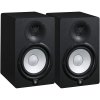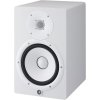Yamaha HS7 Active Studio Monitor
€ 237
| GLS - Pick-up-point | €0 |
| GLS - Home Delivery | €10 |
| GLS - Company Delivery | €10 |
Matching accessories:
- Yamaha HS7
- 2-way bass reflex bi-amped near field study monitor
- With 6.5" woofer and 1" dome tweeter
- 43Hz - 30kHz frequency response
- 60W LF plus 35W HF bi-amp system with high-performance 95W amplifier
- ROOM CONTROL and HIGH TRIM response adjustment
- XLR and TRS jack inputs for both balanced and unbalanced signals
- Yamaha HS 7 also available in white (W)
- Price is per unit.
Yamaha HS7
Yamaha HS 7 is an active studio monitor with great sound reproduction.
Ever since the 70s, the iconic white bass unit has been a clearly visible feature of Yamaha's near-field reference monitors, and a fixture in every major recording studio - and many small ones. Unlike many other studio monitors, which have extra bottom and top and may sound impressive at first "ear shot", the Yamaha HS7 Black is made to give you the most honest and accurate reference from which to build your mix. Yamaha HS7's experienced speaker design team has researched every aspect of what has made the previous Yamaha models the most widely used in the industry. This model: Yamaha HS 7 also includes a 6.5" model, so there are models to suit even more studios.
See also Yamaha HS8 or HS8S subwoofer
The Yamaha HS7 is a studio monitor designed for precise sound reproduction, making it a popular choice for professional audio engineers, musicians, and home studio enthusiasts. With a 6.5-inch cone woofer and a 1-inch dome tweeter, the HS7 provides a balanced frequency response, ensuring that each part of the audio spectrum is represented accurately. It offers a frequency response range from 43 Hz to 30 kHz, allowing listeners to hear both deep lows and clear highs. This broad range is ideal for mixing and mastering, as it enables users to identify subtle details in their recordings.
The design of the HS7 is simple yet effective, focusing on functionality. The cabinet is constructed from high-density MDF material, which contributes to reducing vibrations and unwanted resonance, resulting in a cleaner sound output. The bass-reflex port is positioned at the rear, designed to minimize noise, and it helps the monitor produce a more accurate low-frequency response. This is especially useful when working with bass-heavy music genres, as it ensures the low end remains tight and clear.
Yamaha’s philosophy with the HS series is to create monitors that reproduce sound as accurately as possible, without artificially enhancing any frequencies. This focus on transparency means that the HS7 does not color the sound, allowing users to hear their recordings exactly as they are. This can be particularly valuable during the mixing process, as it ensures that any adjustments made will translate well across different playback systems. The high-resolution sound allows producers to make precise changes, ensuring that their final mix sounds great on any device.
The amplifier section in the HS7 is bi-amped, which means that separate amplifiers power the woofer and the tweeter. This design helps to deliver a more accurate sound by ensuring that each driver receives a tailored signal. The total power output is 95 watts, with 60 watts dedicated to the low frequencies and 35 watts for the high frequencies. This power configuration allows the HS7 to achieve impressive sound pressure levels, making it suitable for both small and mid-sized studio spaces.
To further tailor the monitor to different environments, the Yamaha HS7 includes room control and high-trim controls. These settings help users adjust the output of the speakers based on their room's acoustics. For example, the room control switch can reduce excessive low frequencies that might occur when the monitors are placed near walls. The high-trim control allows users to adjust the higher frequencies, ensuring that the treble remains balanced even in rooms with reflective surfaces.
Aesthetically, the HS7 features a sleek and minimalist design, with a matte black finish and the iconic white woofer cone that Yamaha's HS series is known for. This design not only looks professional but also blends seamlessly into a variety of studio environments. The compact size, with dimensions of approximately 21 centimeters in width, 33 centimeters in height, and 29 centimeters in depth, ensures that the HS7 can fit comfortably on most studio desks or stands without taking up too much space.
The monitor’s connectivity is straightforward, with both XLR and TRS inputs, allowing it to be connected to a wide range of audio interfaces, mixers, and other studio equipment. These balanced inputs help to reduce noise, ensuring a clean signal path from the source to the monitor. This versatility makes the HS7 compatible with various professional and home studio setups.
One of the standout features of the Yamaha HS7 is its ability to perform consistently across different genres of music. Whether mixing rock, electronic, classical, or spoken word, the monitor delivers a clear and accurate representation of the audio. Its neutral sound signature ensures that the listener can hear all elements of a mix with clarity, making it easier to identify any issues that need to be addressed. This characteristic makes the HS7 an ideal choice for both beginners looking to develop their critical listening skills and seasoned professionals who require reliable and accurate monitoring.
Yamaha’s reputation for producing high-quality audio equipment is well-established, and the HS7 is a continuation of that tradition. The brand has been known for its commitment to craftsmanship and sound integrity, and the HS7 lives up to those expectations. Its robust build quality and attention to detail make it a durable choice for long-term use in any studio environment. With a weight of around 8.2 kilograms per unit, the HS7 is solidly built, providing stability and reducing the risk of accidental tipping.
In summary, the Yamaha HS7 is a versatile and precise studio monitor that delivers accurate sound reproduction, making it a valuable tool for music production, mixing, and mastering. Its combination of bi-amped power, room adjustment controls, and high-quality construction ensures that it can adapt to a variety of studio spaces while providing a faithful representation of any audio content. The design, both in terms of aesthetics and functionality, reflects Yamaha’s commitment to helping musicians and producers create the best possible sound. Whether used in a professional studio or a home setup, the HS7 is a reliable choice for those who value clarity and precision in their monitoring.
| Model/Product no.: | YAM-HS7 |
| GTIN | 4957812533010 |
| Height (cm.) | 33,2 |
| Width (cm) | 21 |
| Depth (cm) | 28,4 |
| Weight (kg) | 10 |
| Color | Black |
| Remote control included | No |
| Power consumption when switched on (watt) | 55W |
| Type | Studio |
| NFC | No |
| WiFi | No |
| Airplay | No |
| Wireless Subwoofer | No |
| Frequency range | 43Hz - 30kHz |
| Max / peak output power (watts) | 95W |
General specifications
| Speaker type | 2-way bi-amp powered studio monitor | |
|---|---|---|
| Frequency range (-10dB) | 43Hz - 30kHz | |
| Components | LF | 6.5" cone |
| HF | 1" dome | |
| Crossover | 2kHz | |
| Output power | 95W (LF:60W, HF:35W) | |
| I/O connectors | XLR3-31 type (balanced), PHONE (balanced) | |
| Power consumption | 55W | |
| Shape | Bass-reflex type | |
| Cabinet material | MDF | |
| Dimensions | W | 210mm (8.3") |
| H | 332mm (13.1") | |
| D | 284mm (11.2") | |
| Net weight | 8.2kg (18.1 lbs.) | |
| Others | LEVEL control (+4dB/center click) , EQ: HIGH TRIM switch (+/- 2dB at HF) / ROOM CONTROL switch (0/-2/-4 dB below 500Hz) | |







